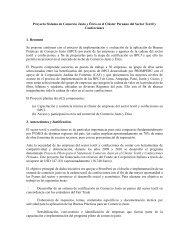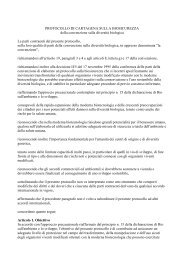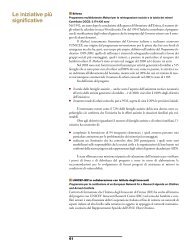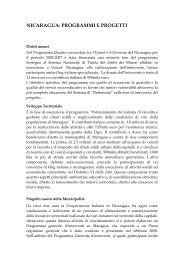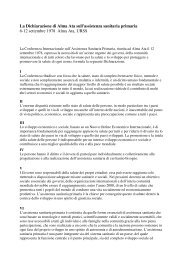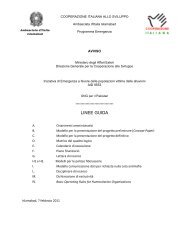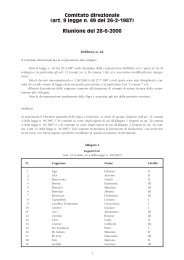FRONTESPIZIO - Cooperazione Italiana allo Sviluppo
FRONTESPIZIO - Cooperazione Italiana allo Sviluppo
FRONTESPIZIO - Cooperazione Italiana allo Sviluppo
You also want an ePaper? Increase the reach of your titles
YUMPU automatically turns print PDFs into web optimized ePapers that Google loves.
50 Sandro Accorsi, Nejmudin KedirSetting baselines and targets is at the heart of the monitoring exercise as thestandards contain observable, explicit statements of service performance, describedin terms of achievement of a target against which the performancecan be measured. Therefore, baselines and targets enable the translation ofpolicies into actions. Setting baselines and targets influences the selection ofperformance indicators; in fact:1. only indicators for which a baseline estimate exists should be selected;2. only indicators for which we can expect at least one additional estimateduring the implementation period of the HSDP III should be selected;3. only indicators for which it can be reasonably expected that the HSDPIII could have some measurable impact in the space of its implementationshould be selected.In order to get standards agreed to, implemented and achieved, there has tobe local 2. only ownership indicators for and which national we can standards expect at least need one additional to be examined estimate during and the explicitlymade relevant to the local situation. There are different techniques to es-implementation period of the HSDP III should be selected;3. only indicators for which it can be reasonably expected that the HSDP III could havetablish some realistic measurable targets, impact based in the space on trends, of its implementation modeling, should benchmarks, selected. projections,In order to get standards agreed to, implemented and achieved, there has to be local ownershipor simulations. An example is provided below, with the target for infant andand national standards need to be examined and explicitly made relevant to the local situation.under There 5 are mortality different techniques reduction to by establish 2010 realistic being targets, based based on historical on trends, trend modeling, analysisbenchmarks, projections, or simulations. An example is provided below, with the target for(Figure 8) and on estimation of the impact of the implementation of HSDPinfantand under 5 mortality reduction by 2010 being based on historical trend analysis (FigureIII 8) and on other estimation intersectoral of the impact activities of the implementation aimed at ofimproving HSDP-III and child other intersectoral survival.activities aimed at improving child survival.TREND IN INFANT MORTALITY RATE(1991-2005, with projection to 2010)TREND IN UNDER 5 MORTALITY RATE(1991-2005, with projection to 2010)140130130220200211INFANT MORTALITY RATE (PER 1,000)12011010090807060504030209777Target 45in 2010UNDER 5 MORTALITY RATE (PER 1,000)180160140120100806040166123Target 85 in 2010102001991-1995 1996-2000 2001-2005 2006-201001991-1995 1996-2000 2001-2005 2006-2010YEARYEARFigure 8: Infant mortality rate and under-five mortality rate in 1991-1995, 1996-2000, 2001-2005 (fromFigure Ethiopia 8: Infant Demographic mortality Health Survey), rate and target under-five for 2010 (according mortality to HSDP rate in III). 1991-1995, 1996-2000,2001-2005 (from Ethiopia Demographic Health Survey), and target for 2010Therefore, the use of a core set of(according sector-wide to indicators HSDP is III). important in order to provide acomprehensive picture of the performance of the health sector, with explicit statement onplanned targets and measurement of actual achievements. The basic principles used forTherefore, the use of a core set of sector-wide indicators is important in order1) to Use provide a common a comprehensive set of sector-wide indicators; picture of the performance of the health sec-developing the monitoring system may be summarized as follows:2) Use common criteria for target setting;tor, with explicit statement on planned targets and measurement of actual3) Use standardized procedures for data collection and reporting as well as a common datadictionary;4) Relate resources available (inputs) with services provided (outputs) and outcomes achieved.As a result, the consolidated report to ARM is based on performance comparison across regionsand trend analysis over time, focusing on the implementation of the activities, and theintermediate steps that determine how inputs are transformed into outputs linked to the ultimate





